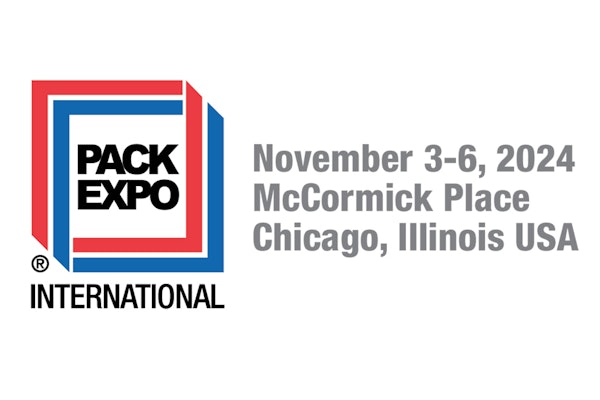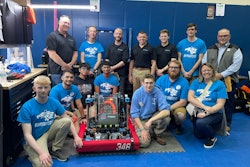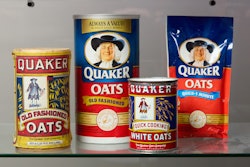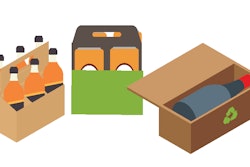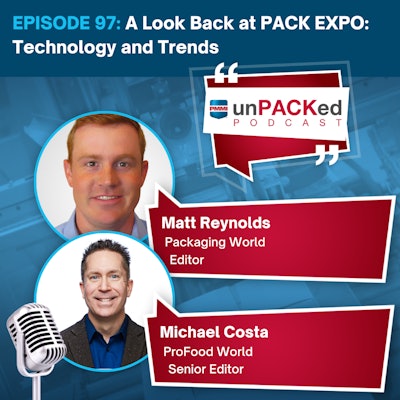
PACK EXPO International returned with a vengeance in 2022, surpassing numbers from the good old days when nobody was familiar with COVID-19, and pandemics were things you learned about in history class. While the show is in the books, unPACKed with PMMI discussed some of the trends and technologies seen on the show floor with PMMI Editors, Matt Reynolds from Packaging World and Michael Costa from Pro Food World. The pair provide just a glimpse at some of the technologies that stood out to their trained eyes as well as trends that continue to emerge.
To subscribe, rate, review, and find more unPACKED podcast episodes, visit pmmi.org/podcast or find us on Apple podcasts, Spotify, iHeart Radio or wherever you listen to your podcasts.
 | Read the full transcript below.
|
Sean Riley:
Hi, and welcome to unPACKed with PMMI. I'm your host, Sean Riley. PACK EXPO International returned with a vengeance in 2022. Surpassing numbers from the good old days when nobody was familiar with Covid 19 and pandemics were things you learned about in history class. While the show is in the books, we can certainly still discuss some of the trends and technologies seen on the show floor. Today we eavesdrop on my conversation with two esteemed PMMI editors, Matt Reynolds from Packaging World and Michael Costa from ProFood World. The pair provide just a glimpse at some of the technologies that stood out to their trained eyes as well as trends that continue to emerge based off of their findings. Let's have a listen.
Hi and welcome to PAC Expo's must see technology and trends. I'm your host, Sean Riley, and today I'm joined by two esteemed PMMI Media group editors. I have to my far right, Matt Reynolds from Packaging World. Welcome Matt.
Matt Reynolds:
Thank you. Thank you for having me.
Sean Riley:
Pleasures all mine. And also Michael Costa from ProFood World. Welcome, Michael.
Michael Costa:
Thank you.
Sean Riley:
So we just wrapped up the first day of the show and it's been a long time since we've been back in Chicago, but I have to think that some of the usual topics, the usual suspects are some of the things that you guys probably saw right away, whether it's things around sustainability, things to solve the workforce crisis, those type of things. So I guess jumping in with you, Michael, is that something that you would say is a fair statement? There's a lot of that out there on the floor, and is there anything in particular that stood out?
Michael Costa:
Yeah, yeah, absolutely. So a few of the trends that I saw walking the show today were the old standbys, labor and energy savings mostly. I know we've heard a lot about these topics over the years, but as each year passes, the solutions become a bit more refined. And so today I stop by a couple of pump manufacturers and for those who don't know what pumps are, what they do in a food processing scenario, there's really only two ways to move food and beverage product through a facility. One is pumps and the other's a conveyor. So pumps are really handy if you have liquids or viscous materials that you obviously wouldn't put on an open conveyor. So pumps and pipes are very important to the industry. One company I visited was Graco and they have a new electric pump, which uses 80% less energy than a traditional pneumatic air diaphragm pump.
And so the idea here is that over the long haul, because compressed air is so expensive to use, can be so expensive to use, that electric pumps are going to save a lot on energy and be more efficient with than compressed air. And then another pump company I visited was Unibloc, which is debuting a line of different sized pumps. So if you're a startup food and beverage company and you're looking to scale up your production, you can pick a size pump that sort of fits what your production model is instead of buying a large, one size fits all pump and that would be an inefficient use of that as your business model is not set up for it yet.
Sean Riley:
Very interesting. Now, how about you, Matt? Anything that would tie in?
Matt Reynolds:
So earlier you mentioned labor savings and energy savings, and you kind of had the microcosm of the pump as an example, but it's everywhere. You're in the Lakeside Hall. I'm over here in the south hall today and the energy savings on equipment is quite important. Every nickel, anything, any area you can save margin is great. And the energy savings is both a cost savings measure and it's also a sustainability measure.
Sean Riley:
It always seems to me as kind of the low hanging fruit to like, "Okay, well if we can cut energy, that's something where now we're being more sustainable." It seems like the first step that people can take to cut that out.
Matt Reynolds:
It is. And it saves on bills as well. So two birds with one stone there. One example, I was at the LinMot booth that's kind of short for linear motion, but LinMot does linear motion servo drives that are replacing, like you mentioned, compressed air. Replacing or one-to-one replacement for what were formerly pneumatic systems and instead of compressed air using electricity, which is a lot cheaper. So a lot of savings can be had there.
Let's see, where else was I? Yamato? Yamato Scales. They have a new product, it's called, I get this right, it's automatic diving funnel for inline tray filling. So the cool thing about this is this used to be a process for leafy greens like tray filling rigid plastics or rigid containers, any kind of container with leafy greens because it's such a light leafy product, a lot of manual operations. This is a way to do a formally manual operation that is going to now be automated. So again, automating anything is labor savings there.
Sean Riley:
Sure.
Matt Reynolds:
So just a couple of areas. Oh, one more Syntagon. They've got a coffee bagger. It's called the PMX Coffee Bagger, that's new at the show. I think it was released earlier this year. But again, this is something that has a condition monitoring system, so that minimizes energy usage as you mentioned. And it also minimizes material usage. And this is a machine that's able to do coffee bag, coffee pouches and so on with monolayer materials, which is another huge trend that we're seeing all over the show floor. So those are just three examples that I saw today that are energy saving and they're labor saving.
Sean Riley:
Yeah, I know the monolayer is a big thing that you've talked about on podcasts and I've seen stories that you've written in Packaging World where people are trying to get either back to or if they've never had a monolayer just because of the whole issue with MERFs and recycling and stuff like that. And it's just an easier material to put out there. Very interesting.
Matt Reynolds:
It's interesting, it's recycle-ready material, but it's not necessarily going to be recycled here in the United States, which is kind of a smoke and mirrors, but it's a necessary step. Right now there's a lot being done on creating a truly circular film- to-film type of recycling. What happens now most frequently is these films, these monolayer films are able to be recycled, whether it's through in-store drop off or maybe it's back of the house, stuff like stretch wrap around pallets and so on. It's very difficult to recycle those. They can be turned into, let's say outdoor equipment like chairs, swing sets or carpeting. But now more and more, there's a story that I'm writing right now that's going to be in the November issue, is talking about true film-to-film recycling. So the monolayer materials really play a starring role in that scenario.
Sean Riley:
Oh, so that's really cool. So as you're, I guess to dumb it down for me, is basically you're taking a film and you're able to recycle it and then reuse it again as a film?
Matt Reynolds:
As another film. Yeah.
Sean Riley:
Awesome.
Matt Reynolds:
Exactly. So I mean, here's some examples I just checked down. Soup Pack has its pure PE polyethylene. And what's interesting about Soup Pack is they make the machine also. So they make both the film itself and this pure PE and the machine and one knock against mono layer materials historically is, especially the early ones, has been they aren't quite as machinable. They don't have maybe the puncture resistance or the machinability qualities because they're only one material. But Soup Pack is actually doing both the material itself and the machine. So it's clearly a machinable polyethylene there. Constania over in the West Hall, they're doing what's called their Perpetua solution, and that's on the polypropylene side. So it's the PP mono material. Henkel and Seed Work. I may be mispronouncing Seed Work, my apologies. Oh yeah, it's a validated oxygen barrier coating so that enables mono materials. Again, when you go to a mono, you don't have the ability to sandwich three or four different layers of functional layers of materials together. You've just got one layer. So that's where the sealant actually provides the barrier. So that's pretty cool. So a lot of cool stuff with monolayer materials. Michael, have you seen anything like that or-
Michael Costa:
Yeah, actually today in Lakeside Hall, his favorite hall. Shout out to Lakeside Hall.
Matt Reynolds:
And it's not just processing.
Michael Costa:
I've heard that. Yeah. So speaking of that, I stopped by TC Transcontinental and they're debuting their line of the [inaudible 00:08:39] recycle Ready PCR packaging materials, it's film. One is 38% PCR, the other is 50% PCR, and they're focused on home and care products like food and beverage, coffee, tea, meat, poultry, that sort of thing. So one of the people I talked to at TC said that 37% of US consumers say the packaging for their products is a factor in their buying decisions. That's not news. But what I thought was interesting was that 49% of household product launches, so new products include a claim for sustainable packaging on the label. So this the Via Verte material, the PCR material is really tying into that trend.
Matt Reynolds:
Yeah, I heard a stat from General Mills not too long ago that, of their entire product line, General Mills is a brand owner that's got a lot of different brands.
Michael Costa:
They do. Yes.
Matt Reynolds:
But the brands that are positioned as sustainable are selling, are growing at a seven times 7X rate compared to their brands that aren't positioned as sustainable brands. So that's just a factor that that's why it's everywhere here at PACK EXPO. And you mentioned PCR at TC Transcontinental. That's a whole lot of acronyms there, PCR. So PCR is post-consumer resin or post-consumer recycled material. Both seem to work.
Michael Costa:
I was going to explain that, but I left that to him.
Matt Reynolds:
But that's another thing. We talked about monolayer materials. PCR is another thing, too. It's not necessarily something that there's a ton of available right now. I think of the PCR available, PET is kind of like the golden chip. There's the most available material there. But increasingly we're seeing PPE and PE streams as well. And one was, let's see, oh, Pro Ampac. Yeah, they've got their line of films for both horizontal and for vertical flow packing, that kind of stuff. And they're doing quite a bit with PCR. PCR and it's high content PCR. It might not be 100% PCR, but it's a higher content. And again, that just reduces the total amount of [inaudible 00:10:43] that's used. And then we mentioned PET, there's also Tekniplex. They've got their 100% PCR egg cartons that they're showing today. But again, there's more available PET. So that's why they can get to that 100% level.
Sean Riley:
Very interesting. Mike, anything else? Because Michael is also our newest PMG editor. He came on board the most recent, so I don't want Matt to take all the attention here. Anything else you saw out there, Michael, that you want to touch on?
Michael Costa:
Yeah, one other aspect, line changeovers, and again, it was a packaging and film company, Winnmoller and Holsher. So they're debuting at the show here, their Easy2change system, like a Prince song, easy, number 2, change.
Sean Riley:
Oh, I like that.
Michael Costa:
So easy to remember. Prince was an artist, children, who was very famous 35, 40 years ago.
Sean Riley:
Yes. Oh, okay.
Matt Reynolds:
They know them in Minnesota.
Michael Costa:
They do. So Easy2change. The whole idea is it speeds up line changes by 70% and it cuts the time to do it in half. So it's not a fully automated system, but it's more of a support tool for line operators. And it's, we talked about line changeovers earlier.
Matt Reynolds:
Yeah, it's huge. I mean, every second that you can, it's downtime. You're taking downtime out of your process by reducing the total amount of changeover time. And one, I mean I saw the same thing you did out on the show floor this time in the South Hall Delcor. They debuted their Trayfecta S series. Trayfecta as a tray erector. But that's a three minute changeover. I mean that when you have a changeover that is that fast, then you're really limiting downtime. Another one was a triangle. They showed what their new delta zipper tape, vertical form field seal. Again, that's mostly for three sided pillow bags, again under 10 minutes for changeover for that. So imagine having in this era of SKU proliferation where you don't just have one size fits all pouch, you've got maybe 10 different sizes and you've got to change that over, again every second that you can save and change over time really helps. And again, just like Michael saw, that's what I'm seeing too on the show floor.
Michael Costa:
And I have to think from, again, we're touched on it and we've mentioned the labor issue. It has to make it easier for labor or new incoming labor. If it is, I mean, I have to imagine if it's three minutes to change over, it's going to be a lot easier than the ones that would take 20 minutes to an hour to change over. It's got to be a simpler process to be able to happen that fast.
Matt Reynolds:
Yeah, absolutely. And with the labor market the way it is, you don't necessarily have access to people who've been there for 20 years and know exactly what is going on. So the more HMIs and changeover systems that are built for really being intuitive, whether that's through what you call a GUI, like a user interface kind situation that's intuitive. Usually a touchscreen HMI and possibly preset recipes or so on. So it's really simple for people, even new folks, to be able to make these changeovers. And a lot of the companies that are creating these fast, all the OEMs that are creating these fast changeover systems, they've got that in mind. They need to make sure that operators are able to do that and follow along without a manual that's a hundred page PDF to do a changeover.
Sean Riley:
Perfect. Well this was awesome. I appreciate you guys. You were both running around from sun up till now covering the show floor and we appreciate you taking a couple minutes to come out here and sort of share with the people at home what they're missing and what they need to get down here and take part in the next couple of days. So I want to thank again Matt Reynolds and thank you, Michael Costa for coming on Must See Technology And Trends.
Please rate review and subscribe. to do that, go to the iTunes podcast or Spotify app on your phone and search for unPACKed with PMMI.
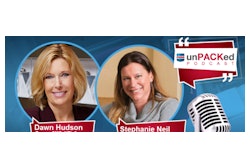
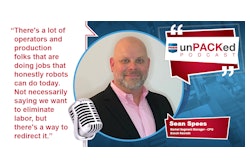
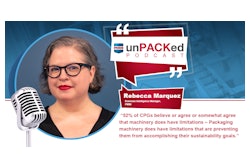
![What we expect in coming years, and actually, towards the second half of this year, is that the demand [for growth] will be driven by trying to address [ongoing] workforce challenges.](https://img.oemmagazine.org/files/base/pmmi/all/image/2022/10/What_we_expect_in_coming_years__and_actually__towards_the_second_half_of_this_year__is_that_the_demand__for_growth__will_be_driven_by_trying_to_address__ongoing__workforce_challenges..63486df187c93.png?auto=format%2Ccompress&bg=fff&fill-color=fff&fit=fill&h=167&pad=5&q=70&w=250)
